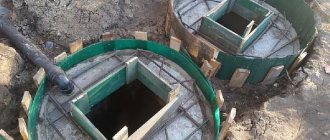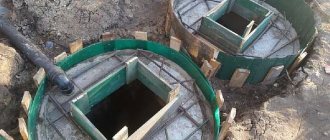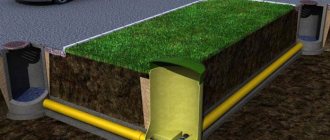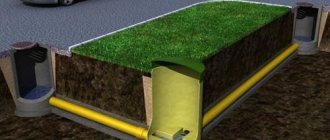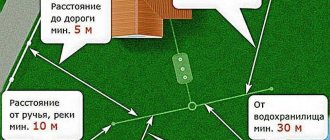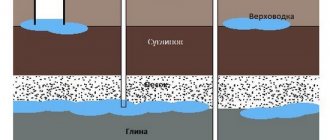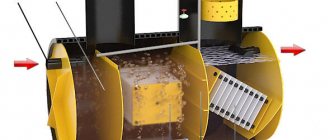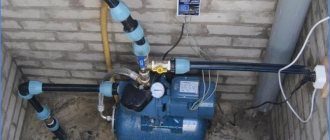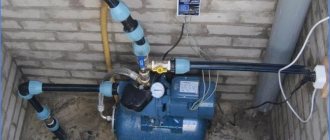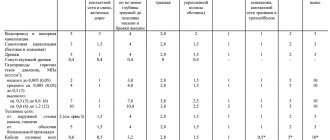The distance from the septic tank to the well can be determined independently according to SNiP. Moreover, you cannot break the rules, because if these structures are too close, there is a risk of wastewater spreading and entering the water supply system. This will lead to contamination of drinking water, which in turn is the most common cause of poisoning.
When choosing a location for arranging a hydraulic structure and septic tank, the size of the site and the type of soil are taken into account.
Rules for the location of the septic tank.
Consequences of incorrect placement
In drilling, the main thing is that the source shaft is located above the aquifer. It is necessary to choose a convenient location that provides access for the drilling machine.
Finding the aquifer is sometimes difficult. For better results, you should pay attention to some side factors:
- geological feature of the site;
- close proximity to surface water;
- typical plant species.
Sometimes it is worth doing exploratory drilling.
There are a number of other factors that must be taken into account when drilling. This is primarily protection from contamination. Incorrect location of the source can lead to runoff, industrial waste and landfills.
The minimum location from the septic tank is at least 30 m, and preferably 50 m. The distance from garbage heaps or industrial warehouses is 100 m or more.
Dimensions of well and septic tank
The septic tank must be sized to accommodate three days' maximum volume of wastewater. During the process of complete separation, the used liquid is decomposed into heavy and light fractions and purified water. Sewage processing in the settling tank takes a long time and therefore a sufficient tank volume is required.
The supply pipe in the storage tank is located at the maximum distance from the overflow. So in horizontal containers they are placed at opposite ends. The greater the number of chambers used for the same volume of a treatment plant, the better the quality of wastewater processing. The efficiency in this case is influenced by the process of mixing the wastewater already present in the settling tank with newly arriving sewage, which is reduced to a minimum.
When creating a drainage well for a septic tank, the volume is not as important as the size of the absorbent surface (about
Rules and regulations
They are regulated by a number of regulatory documents. Namely:
- The rules for the location of external water supply networks are regulated by SNiP 02.04.02-84.
- The rules for the arrangement of sewer networks are established by SNiP 02.04.01-85. The requirements for the sanitary protection zone are also regulated here.
According to these SNiP standards, the following recommendations should be taken into account:
- the source should be located in environmentally friendly coal of the site;
- the recommended distance from the septic tank to the well is 50 m;
- it is necessary to drill above the location of the sump;
- the septic tank is installed 5 m from the residential building and the edge of the road;
- the cesspool is dug at a distance of 4-5 m from neighboring areas.
Features of installation of sewer and water supply communications
Construction codes regulate the laying of pipelines. Communications that deliver water to the house and remove wastewater can be located in parallel. In this case, they should be at a distance of 40 cm from each other.
If it is not possible to lay the pipes according to this scheme, it is permissible to lay them at an angle of 90°. In this case, it is also necessary to maintain a distance of 40 cm between communications, but this time vertically. When pipes are brought into the house, they are spaced further - 1.5 m from each other.
Distance from the house, septic tank, cesspool and neighbors’ fence
The footage from the well to the house does not have a clearly defined value. There are cases when the water source is located directly in the basement of a residential building. The only criteria in this matter are the ability to conveniently access the drilling machine site and not damage the foundation in the event of an accident.
The presence of various communications is taken into account, such as water supply, gas pipelines and electric cables. The mine should be located at least 30 meters from the low-pressure gas pipeline, and 100 m from the high-pressure gas pipeline.
Where to place the well on the site in relation to the septic tank
Depends on the type of soil on it. If the soil is normal, there should be at least 20 m between them.
In conditions of sandy, sandy loam or loamy soil, the source should be located 50-80 meters from the septic tank.
When placing a septic tank or pit on a site, they take into account such an indicator as the hydraulic connection of the aquifer where the well is located and the soil where wastewater can get.
If there is no hydraulic connection and wastewater does not flow directly into the aquifer, the gap can be as short as 20 meters. If the aquifer is not protected, it is increased to 50 meters.
Water quality can be affected by the proximity of a septic tank. It must be removed from the source by at least 30 meters.
Advice: the well should be located above the level of the cesspool to prevent wastewater from entering it, which can lead to contamination of drinking water.
It is also worth considering the question of what distance from the well the well should be located. Although it acts as a source, it can cause pollution due to its design.
In what cases can this system not be installed?
A septic tank that requires filtration fields and removes water with less than 98% purification is not suitable for use in many types of areas, here is a list of all prohibited options:
- the site is located in a sanitary zone, near reservoirs and other water supply sources;
- on rocks that make it difficult or impossible to filter wastewater;
- The site is located on a strong slope in places where landslides are possible. Overmoistening of such soil can cause the earth to collapse;
- the groundwater level is too high, approaching the surface of the site, then it is possible for runoff to enter the groundwater and contaminate all surrounding soil and water bodies;
- there is no space on the site to create the necessary filtration fields, or it is not possible to maintain all the necessary distances specified in SNiPs.
Responsibility for non-compliance with SNiP and rules
The construction of wells in a suburban area must, along with construction standards, also comply with legislative sanitary rules - SanPiN. This is especially true for cesspools, which require some care.
Any type of septic tank or waste pit must be cleaned twice a year with a sterilizing mixture. This is done after pumping out with a sewer truck. A special solution is used, which contains acid and gentle compounds.
Violation of sanitary rules is subject to a fine and, in some cases, a court order to remove the septic tank from the site.
Materials for building a septic tank and well
Monolith made of reinforced concrete
. The advantage of this option is the minimum cost. The cost item will consist of the cost of purchasing sand, crushed stone and cement.
For the construction of formwork, different materials are used - old boards, plywood, slabs and other materials.
For reinforcement, pipe scraps, remnants of metal corners and other metal products are used. An overflow pipe is installed between the chambers of the septic tank, using a vertically oriented tee in the primary settling tank, which allows you to remove the settled liquid below the crust that forms on the surface. In the photo you can see what a reinforced concrete monolithic septic tank looks like.
Finished rings
. The use of reinforced concrete products allows you to equip a septic tank from well rings and thereby significantly reduce construction time. True, the price of the treatment plant will be higher. This design can be used a few days after the start of work.
During construction, it is necessary to remember that:
- the lower ring must have a sealed bottom;
- the seams are treated with a solution of cement and sand (in a ratio of 1:3), adding liquid glass. After the composition has completely hardened, bitumen mastic is applied to the joints;
- If you don’t want to make holes in the rings yourself, you can buy ready-made perforated products for local sewerage.
The main thing to remember when installing a sewer system in a private home is that you cannot install a septic tank next to a well, which is a source of drinking water.
Location of the septic tank on the territory of a private household
It is necessary to take into account a few more points when placing such structures on a suburban area:
- The minimum distance between the septic tank and the nearest streams and reservoirs is 10 meters. The maximum distance to a septic tank according to the standards is three dozen.
- Vegetation position. It is necessary to retreat to a distance of up to 4 meters from the roots so that the process of rotting does not begin. This is important for crops in which the root system is especially actively developed. But flower beds thrive on filtration systems. Their distance to the septic tank can be any.
- It is mandatory to use a straight pipeline extending to the tank from a residential building. It is permissible to install a rotary well if it is difficult to resolve the issue. But such systems are considered less reliable and more complex.
- 5-7 meters is the optimal distance of septic tanks from residential premises. If the installation is further, blockages will appear on the route. It will be necessary to install an intermediate well if the gap is more than 15 meters.
- Any soil is suitable for placing modern containers. It is good if the soil in the area is soft and dry. Then it will be easier to dig pits and trenches in the future.
- What about pumping at the septic tank? It is worth thinking in advance about having specialists easily approach the site and clean the containers. Transport operates at a distance of up to 50 meters. The equipment is installed taking this factor into account.
- There should be at least 7-15 meters to buildings. This is necessary so that the foundation of the building does not wash away. Otherwise, the premises and the building itself will quickly collapse in wet weather.
back to menu ↑
Sanitary-hygienic facilities
The distance from the well to the septic tank on the site is an important parameter on which supervisory authorities especially concentrate. The human life support system necessarily includes the consumption of drinking water and the productive activity of the urinary system.
Septic tank at the dacha
The emergence of new products for developers aimed at solving the problem has led to a revision of strict guidelines on what the minimum distance should be between the septic tank and the well:
- The existing standards for the distance between a source of clean water for drinking and a sewer pit were developed at a time when the prevailing option for waste was a birdhouse-type toilet and a primitive cesspool, and the source for drinking was a well dug with one’s own hands.
- The sanitary and hygienic standards for the placement of a septic tank and a well and the distance between them of 50 m are also aimed at summer cottages where there was neither an autonomous water supply nor modern types of toilets. The absence of a centralized sewerage system made it necessary and a priority element in development planning to take into account sanitary and hygienic standards (SanPiN). Anti-epidemiological protection standards, for obvious reasons, indicated the maximum distance between the well and the septic tank in order to avoid contamination of drinking water and soil, especially aquifers.
- The choice of location for a well and septic tank today is determined not so much by sanitary standards as by the requirements specified by the manufacturer, taking into account the characteristics of the purchased system or type of toilet.
- The standards specified in the SNiP rules are now focused on the distance from the house to the neighbor’s home, as well as to other sanitary and hygienic structures. However, no one prohibits installing a water supply and autonomous sewage system directly in the building.
- Installing the system inside a residential building or garden house on any type of plot can be a hassle-free solution and will serve for a long time. To do this, it is necessary to take into account two important points - obtaining permission to construct a system or a separate object on the site and registration documents that are still required when constructing devices of a certain type.
Septic tank near the well of a private house
The location of the septic tank on the site may vary depending on the type that the developer chose for reasons of expediency, functionality or inexpensive cost.
Some of them (for example, a powder closet or a dry closet) can be located not only at a minimum distance, but also directly in the room itself.
Results
- If you decide to install an autonomous sewer system on your site with your own hands, you need to obtain permission for the project from the SES. Firms usually coordinate a septic tank project on their own;
- To develop an installation plan, you should study the following documentation: SNiP 2.04.03-85 (external sewer networks), 2.04.04-84 and 85 (external water supply networks), SanPiNs for the creation of security zones around environmentally hazardous objects;
- When designing an autonomous sewer system, you need to know the type of soil of the site and the height of the groundwater;
- The drainage well should be removed from the house and neighboring property;
- Trees and bushes should not grow near the septic tank. Their wide root system can damage pipes and containers.
Compliance of your autonomous sewage system with sanitary and building standards will ensure reliable operation of the system and protect you from fines.
Distance to site boundaries
Such restrictions are aimed at preventing the spread of stench to neighbors' properties. When simultaneously constructing several neighboring houses and laying communication networks, it is recommended to discuss the placement of the sewerage system in advance. Thanks to this, the homeowner will be able to correctly place it on the site, and in the future avoid various disputes with neighbors about this matter.
The distance to the fence from the septic tank, according to articles of SNiP and other regulations, should be from 2 meters.
Sanitary standards also regulate the procedure for placing pipelines on the site. The distance between the water supply and sewer pipes should be more than 10 meters. Thus, this prevents sewage from entering the pipeline if, as a result of an emergency or blockage, the pipe depressurizes.
As a rule, autonomous sewerage is located below wells and boreholes. If this is possible, it is advisable to slightly increase this distance to minimize the likelihood of waste liquids penetrating into the water supply.
Watch the video
Podkapaev.ru How not to install septic tanks and wells?
Why is a septic tank dangerous?
A septic tank is associated with the following risks for humans and the site:
- flooding of buildings;
- contamination of the site with sewage due to overflow and untimely cleaning of the septic tank, or during floods;
- the main danger is the release of waste into the soil and aquifers, i.e. literally into your glass. How can this happen if the plastic tank is durable and airtight? There are several reasons for this. These are installation errors, errors when choosing a location for a septic tank on the site, as well as rupture of pipes and depressurization of joints. Alas, no one is immune from emergency situations - we can only reduce the severity of possible consequences, and this is possible if we find the most suitable place for a septic tank, away from wells, boreholes, and reservoirs.
Of course, ideally, it is better to choose a place for a septic tank at the stage of planning the entire site. Then it will be possible to arrange all buildings and communications in an ideal way. But more often you have to look for a suitable place when the house and barn are built and the site is landscaped. In this case, it is better to draw a site plan to scale, mark the house, all outbuildings, the fence, neighboring houses, trees, wells and boreholes. Then you need to arm yourself with a ruler and look for the optimal place so as not to violate any of the rules listed below. If independent research does not produce results, it is better to call for help from specialists who will additionally analyze the type of soil, the depth of groundwater and indicate the best location and depth for installing the septic tank.
Distance of the septic tank from other objects
Sanitary standards regulate the distance not only between the septic tank and the well. The distance from other objects is also strictly established. be located at least 5 meters from the roadway . If it is located closer, then constant vibrations from passing traffic may disrupt its seal. The same distance should be between the treatment plant and the home, as well as various pipelines. This object should not be placed too close to the house, not only because of possible unpleasant odors. This threatens the destruction of the foundation, which can occur due to increased soil moisture.
The distance between the septic tank and the neighboring fence is also a regulated value. It is 2 m. The placement of the treatment plant itself must be agreed upon with the neighbors.
